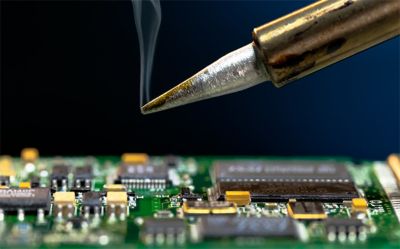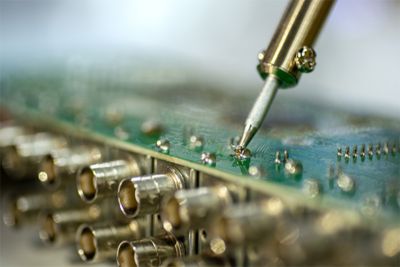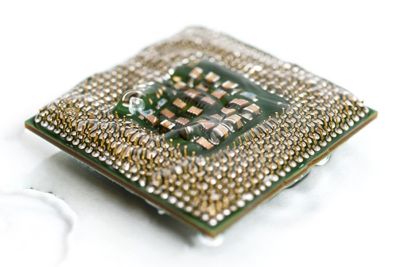-
Ansys is committed to setting today's students up for success, by providing free simulation engineering software to students.
-
Ansys is committed to setting today's students up for success, by providing free simulation engineering software to students.
-
Ansys is committed to setting today's students up for success, by providing free simulation engineering software to students.
-
Contact Us -
Careers -
Students and Academic -
For United States and Canada
+1 844.462.6797
ANSYS BLOG
December 5, 2019
What Is Flux Residue and Why Can It Cause Electronic Failures?
Flux is an acidic mixture that is used to remove metal oxide and create good metallurgical bonds during the soldering process. The downside is that the flux residue left after soldering can lead to electronics failures and current leakage.
Engineers need to understand the soldering process to reduce the
amount of flux residue and improve electronics reliability.
When engineers speak of benign or active flux residue, they are referring to the risk of failure — not the chemistry of the residue itself. No single term or single test captures all the information required to understand the risk.
What is understood is that as circuits continue to shrink, the risk of failure increases. To reduce this risk, engineers need to understand the chemistry, application technique, design and its use case environment.
The Chemistry of Soldering and Flux Residue
There are four constituents of flux that affect the chance of electrical failure:
- Activators
- Binders
- Solvents
- Additives
However, activators and binders have the biggest affect.
Flux residue on a circuit board
Activators are weak organic acids that are found in contemporary fluxes. Their acidity poses a risk but is required for a good joint. The acids react with metal oxides to form metal salts. After a wetting process, the salts dissolve and a metallurgical bond is formed.
Sometimes, the acid may not be fully consumed. When this happens, the excess acid can cause electronic failure. To reduce the risk, engineers need to use a minimum amount of flux for proper soldering.
The binders, sometimes called vehicles, are insoluble-in-water compounds with high melting points (such as natural rosin and synthetic resins). After soldering, they prevent unconsumed activators from dissolving in water. The binders form the bulk of the visible residue. To maintain the appearance of resin-free, clean assemblies, many engineers choose a flux formulation with low concentrations of binders — potentially increasing the risk of failure.
The solvent is used to dissolve the other constituents. The manufacturing-recommended soldering profile is based, in part, on the solvent’s boiling point. During application, it’s important to follow the profile to ensure all of the solvent is evaporated away. If any solvent remains, electronics failure is possible.
Additives — plasticizers, dyes or antioxidants — compose a small portion of the chemical composition of a flux. The additives may increase reliability, but there is no way to gain insights or controls into their functionality due to the manufacturer’s intellectual property protections.
The Risks of Various Soldering Processes
Engineers can use surface mount reflow (SMT), wave, select or hand soldering. Each poses a risk due to the different volumes of flux used.
SMT is one of the cleanest options: It utilizes a paste flux that is applied using stencils or printers. This method has high control on the volume applied.
Liquid flux poses a greater risk than paste because it’s harder to control the application flow and volume.
Hand soldering
The liquid is dispensed by hand or in a spray or foam format during wave or select soldering. In the wave process, the liquid can flow to the top side of an assembly. When this happens, the temperature on the top side of the board may not be high enough to evaporate the solvent. A similar problem can happen with hand soldering, due to the differences in application control among employees.
To reduce the risk of excess and hard-to-control liquid flows, engineers could use flux core solder wire and dispensing equipment with consistent application methods.
How to Measure Assembly Cleanliness
There are several industry-standard methods to collect data that can be used to interpret the risk level after soldering.
The resistivity of solvent extract (ROSE) test can monitor ionic cleanliness during cleaning operations. The data this test collects help engineers maintain a qualified solder and wash process.
Ion chromatography is another popular technique to measure the number of ions left after soldering. It is also an easy way to detect the amount of weak organic acids from the flux.
A humid, use environment can lead to failure.
One challenge to ion chromatography is that different methods will produce different results. For instance, a full-assembly soak will provide concentration averages across the surface. To detect acids in a smaller area, engineers will need to use more localized sampling methods. Unfortunately, there isn’t a standard pass or fail criterion for ion chromatography results.
Engineers can also perform functional testing to assess how a design will perform in humid, worst-case environments. In these cases, failure is typically linked to leakage or shorting. Engineers can use current limiting to reduce the damage from shorting, which could hide any evidence of residue-causing failures.
Engineers will need to rely on the knowledge of their design, end-use environment and cleanliness data to assess risk. This is because there are numerous factors affecting risk, including:
- Flux chemistry/application
- Electrical spacing
- Dielectric strength
- Frequency
- Potting/coating adhesion
To learn more about improving electronic reliability, register for the webinar — Flux Residue: Key Factors Causing Electronics Failures. Or, read about our Reliability Engineering Services.
See What Ansys Can Do For You
See What Ansys Can Do For You
Contact us today
Thank you for reaching out!
We’re here to answer your questions and look forward to speaking with you. A member of our Ansys sales team will contact you shortly.















